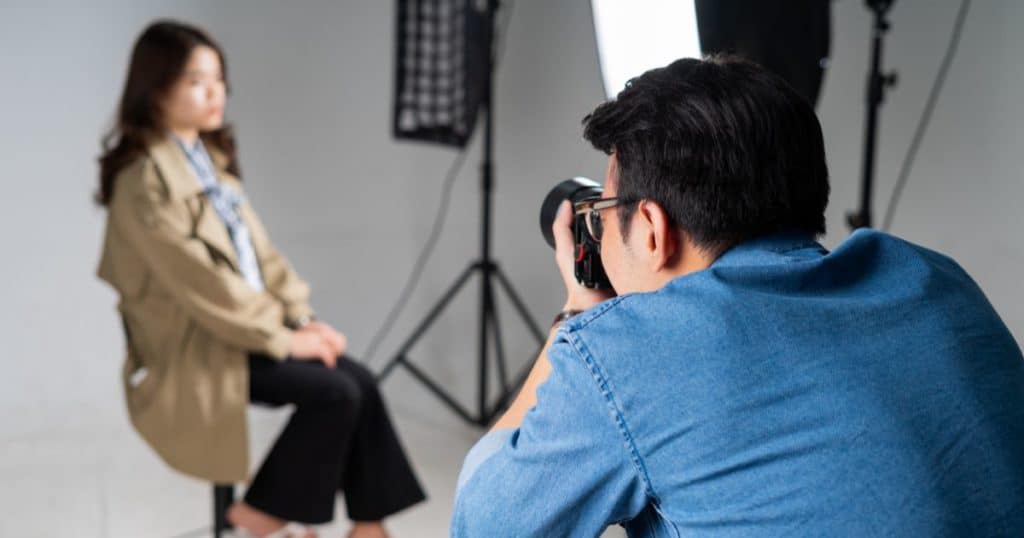When it comes to capturing memories, there's nothing quite like a portrait photograph. Whether it's a family portrait, senior photo, lifestyle pictures, or headshot, a portrait has the power to freeze a moment in time and bring back memories for years to come.
But what is portrait photography, and how do you go about capturing the perfect shot? In this article, we'll dive into the world of portrait photography, covering everything including what it is, the different types of portrait photography, and tips for taking the best shots.
What Is Portrait Photography?
Portrait photography is one of the most common types of photography. It involves capturing a person’s essence, likeliness, character, and personality, in which the face of the subject is the main focus. It’s usually created through the strategic use of composition, posing, backdrops, and lighting.
This form of photography has been around for centuries, with the earliest known portrait dating back to the ancient Egyptians. It often serves several purposes, from capturing special family memories to creating professional headshots for actors and models.
Portrait photography goes beyond just taking the photograph of the subject’s face. It’s about using a combination of skill and creativity to create art that tells a story and evokes emotions.
Professional photographers typically use four different approaches to create the perfect images of their subjects. These include traditional, candid, creative, and conceptual.
- Traditional or constructionist approach: This is the most classic and timeless of all portrait photography styles. The focus is to capture a magical and well-polished image of the subject. It’s often used for formal occasions, like graduations, weddings, and family portraits.
- Candid portraits: This approach is the opposite of traditional portraiture. It involves capturing a person in their natural environment, such as their home, without any posing or manipulation.
- Creative approach: Creative portraiture is all about pushing the boundaries of what’s possible with portrait photography. It usually involves digital manipulation, and is often used for exhibitions and galleries.
- Conceptual approach: This style of photography aims to tell a story, convey a message, or create an emotional response. It requires a lot of planning and collaboration between the photographer and the subject.
What Are the Different Types of Portrait Photography?

Portrait photography comes in many different forms, each with its unique style and purpose. Understanding the different types of portrait photography will help you make the best decisions when it comes to capturing the perfect image of your subject. In this section, we’ll take an in-depth look at some of them.
Studio Portraits
Studio portraits are typically taken in a controlled environment, such as a studio. They’re great for capturing a polished and professional look, as you can control the lighting, background, and poses.
These types of portraits are usually taken with a neutral background and studio lighting, and the subject is usually dressed in formal attire.
Environmental Portraits
Environmental portraits usually put more importance on the subject’s environment. They’re great for reflecting a person’s uniqueness or personality.
Street Portraits
As the name suggests, street portraits are often taken on a city’s streets. They’re great for capturing candid moments and showing the diversity of people in a city. They also help showcase the unique personalities of different people.
Fine Art Portraits
Fine art portraits are highly stylized and artistic, and are used for exhibitions and galleries. They’re usually taken with a creative and artistic approach, using different lighting and composition techniques.
Headshots
Headshots are tight, close-up photos of the subject's face, and are used for professional purposes, like casting, auditions, or portfolios. They are usually taken with a shallow depth of field, to blur the background and make the subject stand out.
Lifestyle Portraits
Lifestyle portraits are more modern and relaxed than traditional portraits. They are typically shot in the subject’s real environment, rather than in the studio. However, the photographer may still use lighting setups to make it a bit more realistic and natural.
Boudoir and Glamour Portraits
These portraits are usually intimate and sensual. They highlight the subject’s beauty and sex appeal. In this type of portrait photography, the lighting is usually well-controlled, and the background is plain and unobtrusive.
Conceptual Portraits
These portraits have a strong concept or theme, often with a strong message or meaning. They are often highly stylized and created to be displayed as art.
Surreal Portraits
To create surreal photographs, photographers utilize elements of surrealism and fantasy. This usually involves a lot of digital manipulation so a dreamlike image is produced.
Family or Group Portraits
These are portraits that capture a group of people, usually family members. Family portraits can be taken in a studio or environmental setting, and are often used for special occasions, like weddings, graduations, and family reunions.
How to Take the Best Photographic Portraits

Taking the best photographic portraits requires a combination of technical knowledge, creativity, and an understanding of the subject. It's all about capturing a person's unique personality in a way that is both beautiful and true to who they are.
When taking portraits, it's essential to understand the basics of photography, such as exposure, shutter speed, aperture, and ISO to manipulate lens exposure. These technical elements play a crucial role in creating the perfect shot.
For example, using a low aperture (f-stop number or lens opening) will create a shallow depth of field, which blurs the background and makes the subject stand out. Understanding the relationship between these technical elements and how to effectively use them will help you create beautiful portraits.
Lighting is also crucial when taking portraits. Natural light can be beautiful, but it can be challenging to work with. It's essential to understand how to use light effectively to create the perfect shot. You can try experimenting with different angles and reflectors to find the perfect lighting for your subject.
Another important aspect of portrait photography is getting to know your subject. Take some time to talk to them, ask about their interests and hobbies, and get to know what makes them unique. This will help you create a connection with your subject, making them feel more comfortable and relaxed in front of the camera.
When it comes to poses, it's essential to experiment with different angles and positions to find the perfect shot. Don't be afraid to try out different poses and see what looks best on your subject.
Challenges of Portrait Photography
If you’re thinking about starting a portrait photography career, it’s important to know that it can also come with its fair share of difficulties. Understanding the challenges involved can help you be better prepared, develop the necessary skills and techniques, and set realistic expectations for yourself and your clients.
Working with a Variety of Subjects
Portrait photography involves working with different types of people, each with their own personality. This can be challenging, as each person may require different posing, lighting, and communication techniques.
Dealing with Nervous or Self-conscious Subjects
Some people may feel nervous or self-conscious in front of the camera, which can make it difficult to get the perfect shot. As a result, you need to have the patience and tolerance to put them at ease and make them comfortable.
Lighting and Equipment
Finding the right lighting and equipment for a portrait shoot can be challenging. Whether it's natural lighting or an artificial light source, you need to know how to use it to create the desired effect and mood.
Post-processing
This is an important aspect of portrait photography, but it can be challenging to get the perfect balance between enhancing an image while still keeping it true to reality.
Dealing with Rejection
Portrait photography is a competitive field, and you might face rejection or criticism. Dealing with rejection and criticism can be challenging, but it’s important to learn from it and not let it discourage you.
Conclusion
What is portrait photography? Portraiture is a powerful medium for photographers to capture amazing images of their subjects. From traditional headshots to candid moments, portrait photography offers endless possibilities for creativity and expression.
The key to great portrait photography is understanding your subject, finding the perfect lighting and composition, and having the passion to bring out your unique personality.
Remember, there’ll always be challenges and difficulties. But with time, patience, and practice, you’ll become better and more efficient at capturing the beauty and personality of your subjects.
